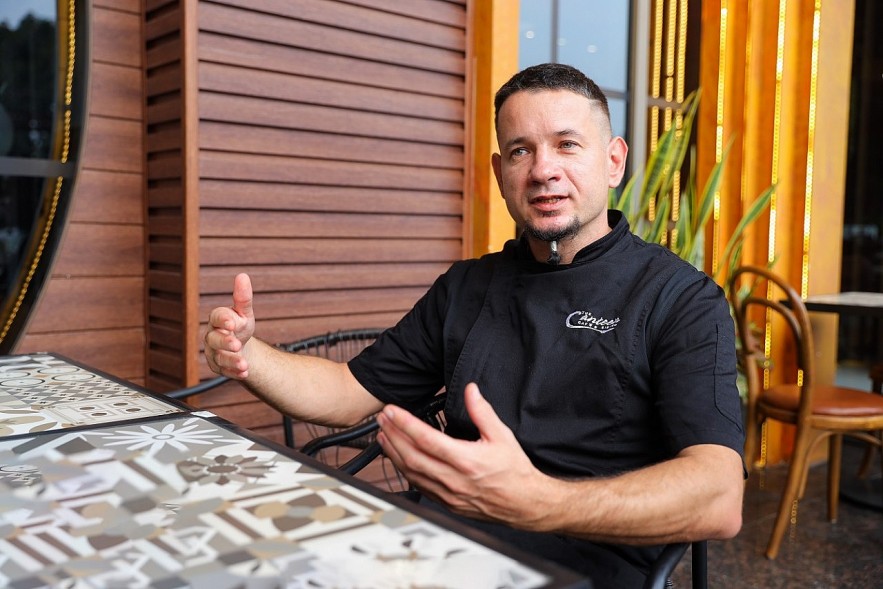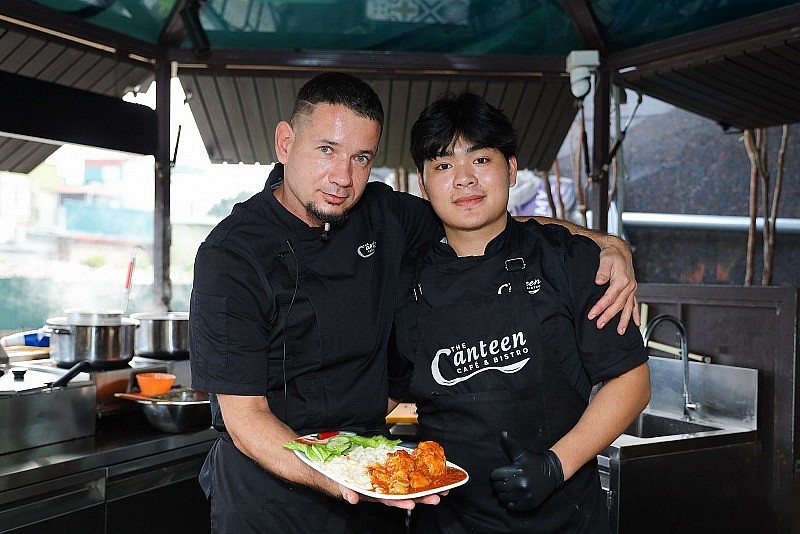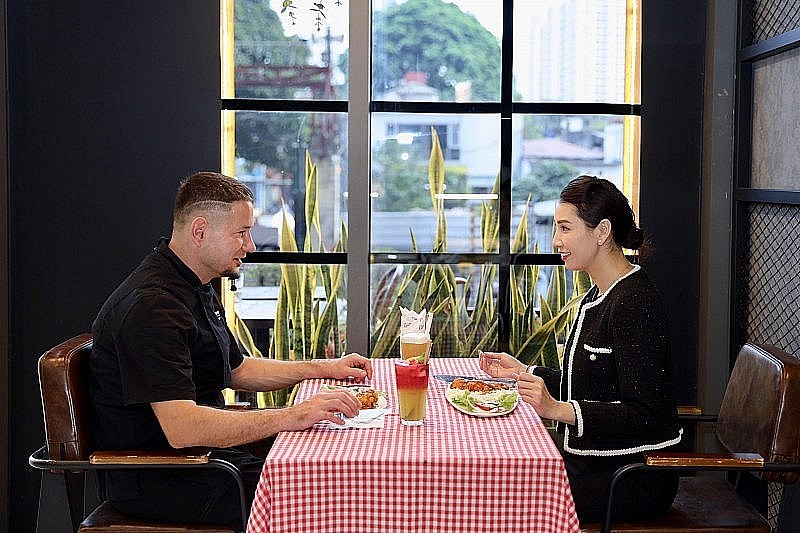A Taste of Hungary in Vietnam
In the late afternoon on an early day in March 2024, we had the pleasure of meeting Csaba Szabo (44 years old) at Canteen, a Hungarian restaurant located on Dinh Cong Street, Hoang Mai, Hanoi. In the open kitchen, Csaba and his colleague were busy preparing a classic Hungarian dish called Chicken Paprikash.
| Chicken paprikash is one of the most beloved and well-known dishes in Hungarian cuisine, with a history dating back to the 19th century. This traditional dish originated among Hungarian peasants and has since become an icon of Hungarian gastronomy. |
Csaba Szabo spent 2 hours preparing Chicken Paprikash, with chicken and paprika as the main ingredients. The chicken was stewed in a sauce flavored with fresh, high-quality paprika. Chicken thighs were first browned, then combined with fresh vegetables and spices such as onions, garlic, and of course, Hungarian paprika. This combination gives the dish its unique flavor and aroma.
Csaba shared, “Spicy flavors are popular in Hungarian dishes. One of the secrets to preparing this dish is using the best quality paprika. Hungarian paprika adds a distinct character to Chicken Paprikash, and its spiciness is highly appreciated by fans of traditional food. Sour cream is also an essential ingredient. Its richness perfectly complements the spiciness of paprika, further enhancing the flavors of the dish. Chicken paprikash is usually served with noodles or dumplings and is a common dish on Hungarian family holiday menus. Many restaurants and eateries also offer this delightful dish to their customers.”
 |
| Csaba Szabo – a Hungarian chef in Vietnam. (Photo: Dinh Hoa) |
“We prepare all our dishes without any modifications to preserve their originality. Just like traditional kitchens around the world, Hungarian cuisine is based on easily grown vegetables that are suitable for the climatic and agricultural conditions of the region. Hungarian cuisine wouldn’t be complete without tomatoes, peppers, carrots, potatoes, celery, parsley, and paprika. We source all our ingredients from Family Foods Market, which is run by a Vietnamese expat in Hungary. Sometimes, we import ingredients from Hungary to ensure that local enthusiasts can enjoy authentic Hungarian flavors of the same quality,” explained Csaba.
As a child, Csaba Szabo spent a lot of time in the kitchen cooking with his grandmother. He loved assisting her in preparing their daily lunches. At the age of 8, he cooked his first beef stew.
 |
| Csaba, his colleague, and Chicken Paprikash. (Photo: Dinh Hoa) |
He also shared, “Alongside the famous Hungarian Goulash and Chicken Paprikash, beef stew is another family recipe that has been passed down through generations. It will also be featured on our restaurant’s menu. As a Hungarian chef, my goal is to introduce the most popular Hungarian dishes to the Vietnamese people. I’m not aiming for a modern or trendy style at Canteen. Instead, I want to showcase the original, simple, clean, and authentic Hungarian dishes that our parents and grandparents used to make daily.”
“I Love Everything About Vietnam”
Despite being busy with the opening ceremony of the Hungarian culinary corner in Hanoi, which is set to take place on March 15th, Csaba Szabo was enthusiastic when asked about his “harmonious relationship” with Vietnam. According to the chef, he loves everything about Vietnam, from its nature and cuisine to its people.
 |
| Csaba Szabo and Hanna Nguyen (a Vietnamese in Hungary) enjoying a traditional Hungarian dish prepared in Vietnam. (Photo: Dinh Hoa) |
According to Csaba Szabo, he has a passion for traveling and discovering new places, cultures, and flavors. He has traveled to over 40 countries worldwide, including a journey on the Trans-Siberian Express from Moscow to China, and a trek along the famous European pilgrimage route, the “Camino,” covering over 700km from the Portuguese capital Lisbon to Santiago de Compostela in Spain. He has driven through Death Valley in California, strolled along Miami Beach in Florida, and dived in one of Cambodia’s hidden gems.
“My trip to Vietnam was unforgettable. I arrived in Vietnam in 2020, right at the start of the Covid-19 pandemic. After going through several health checks, I was finally able to enter Vietnam. As all tourist attractions were closed at that time, I decided to change my plans and took a train to Da Nang after just two days. After about three weeks of strict lockdown, I was able to move around more freely. It was remarkable to see how well and professionally the local government managed the situation despite the inconveniences. While Europe and many other parts of the world struggled to contain the virus, Vietnam managed to largely suppress it in just under five weeks. I felt safe here, even safer than if I had been at home,” he emphasized.
For Csaba, his journey truly began at that moment. He bought an Attila motorbike and rode along the coastline, covering 100-150 km a day. If he liked a place or city, he would spend a few days or weeks there. He passed through Hoi An, Quang Ngai, Qui Nhon, Nha Trang, made a detour to Da Lat, and continued his journey to Mui Ne, Phan Thiet, Vung Tau, and finally, Ho Chi Minh City. Out of all those cities, he said, “Mui Ne Hills and Ho Chi Minh City are my absolute favorite places; I have returned to them almost every year since then.”
“Vietnam is one of the most beautiful countries on earth, with unique natural attractions and an excellent culinary experience. However, the greatest thing about Vietnam is its people. Initially, I experienced a kind of reserved behavior, but once the ice was broken, I found the Vietnamese people to be kind-hearted, friendly, and hospitable. I have great respect for the Vietnamese people for remaining a strong and proud nation despite their painful historical past. They maintain a positive outlook on life and exhibit kindness, smiles, and generosity despite facing many difficulties and hardships. I am still here in Vietnam thanks to the open-mindedness and hospitality of the Vietnamese people,” Csaba shared.
| The Canteen Cafe & Bistro was established by Nguyen Thi Van Anh (Hanna Nguyen), a Vietnamese in Hungary. Born in Bac Ninh in 1987, Van Anh graduated from the Academy of Finance in Vietnam in 2009 and went on to study at Oxford Brookes University in the United Kingdom. She later pursued her graduate studies in Hungary. Van Anh made a home for herself in Hungary and worked for a multinational corporation. However, with the desire to start her own business in her home country, she returned to Vietnam in 2019 to embark on projects related to business and education. In March 2024, Van Anh launched The Canteen Cafe & Bistro, the first Hungarian culinary cultural space in Hanoi. |



